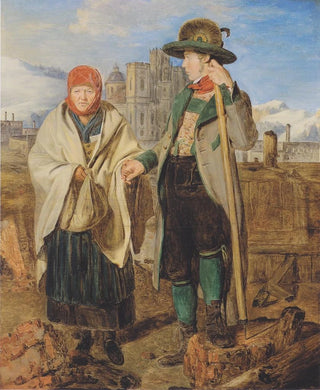Art print | Scene after the fire of Mariazell - Ferdinand Georg Waldmüller


View from behind

Frame (optional)
Art print Scene after the Mariazell fire - Ferdinand Georg Waldmüller – Captivating introduction
The canvas "Scene after the Mariazell fire" by Ferdinand Georg Waldmüller is an iconic work that immerses the viewer in a dramatic and poignant moment. Capturing the essence of a tragic event, this painting evokes powerful emotions while highlighting human resilience in the face of adversity. Waldmüller, master of realism, succeeds in immortalizing a scene full of impact, where each character seems to tell a unique story. Through this work, the artist invites us to reflect on the fragility of life and the strength of community—timeless themes that still resonate today.
Style and uniqueness of the work
Waldmüller's style is characterized by meticulous realism, where every detail is carefully observed and rendered. In "Scene after the Mariazell fire," light plays a central role, illuminating the faces of the characters and emphasizing the nuances of their emotions. The colors, both vivid and dark, create a striking contrast that enhances the dramatic atmosphere of the scene. The artist manages to capture despair and hope, harmoniously blending elements of nature and human figures. The composition, meanwhile, is skillfully orchestrated, guiding the viewer's gaze through the work while highlighting the interaction between the characters. Waldmüller, through his realistic and sensitive approach, succeeds in transcending the simple event to offer a reflection on the human condition.
The artist and his influence
Ferdinand Georg Waldmüller, born in 1793 in Vienna, is considered one of the greatest representatives of Austrian realism. His career, marked by an incessant search for truth and authenticity, led him to explore various themes, ranging from daily life to significant historical events. Influenced by Romanticism, Waldmüller was able to distance himself from it to develop a style that is uniquely his own, emphasizing attentive observation of the world around him. His work had a significant impact on his contemporaries and paved the way for many

Matte finish

View from behind

Frame (optional)
Art print Scene after the Mariazell fire - Ferdinand Georg Waldmüller – Captivating introduction
The canvas "Scene after the Mariazell fire" by Ferdinand Georg Waldmüller is an iconic work that immerses the viewer in a dramatic and poignant moment. Capturing the essence of a tragic event, this painting evokes powerful emotions while highlighting human resilience in the face of adversity. Waldmüller, master of realism, succeeds in immortalizing a scene full of impact, where each character seems to tell a unique story. Through this work, the artist invites us to reflect on the fragility of life and the strength of community—timeless themes that still resonate today.
Style and uniqueness of the work
Waldmüller's style is characterized by meticulous realism, where every detail is carefully observed and rendered. In "Scene after the Mariazell fire," light plays a central role, illuminating the faces of the characters and emphasizing the nuances of their emotions. The colors, both vivid and dark, create a striking contrast that enhances the dramatic atmosphere of the scene. The artist manages to capture despair and hope, harmoniously blending elements of nature and human figures. The composition, meanwhile, is skillfully orchestrated, guiding the viewer's gaze through the work while highlighting the interaction between the characters. Waldmüller, through his realistic and sensitive approach, succeeds in transcending the simple event to offer a reflection on the human condition.
The artist and his influence
Ferdinand Georg Waldmüller, born in 1793 in Vienna, is considered one of the greatest representatives of Austrian realism. His career, marked by an incessant search for truth and authenticity, led him to explore various themes, ranging from daily life to significant historical events. Influenced by Romanticism, Waldmüller was able to distance himself from it to develop a style that is uniquely his own, emphasizing attentive observation of the world around him. His work had a significant impact on his contemporaries and paved the way for many






